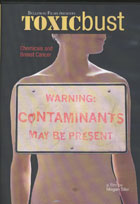
Toxicbust: Chemicals and Breast Cancer 2006
Distributed by Bullfrog Films, PO Box 149, Oley, PA 19547; 800-543-FROG (3764)
Produced by Megan Siler and Plumb Pictures
Directed by Megan Siler
DVD, color, 41 min.
College - Adult
Health Sciences, Women's Studies, Environmental Studies, Science, Chemistry
Date Entered: 11/13/2006
Reviewed by Lori Widzinski, Health Sciences Library, University at Buffalo, State University of New York“…we’re conducting a vast toxicologic experiment and it’s our children and our children’s children who are the experimental subjects.”
-Dr. Philip Landrigan of Mt. Sinai School of Medicine, one of the experts featured in the film Toxicbust, Chemicals and Breast Cancer.
The film mixes a bit of docudrama together with screens of current statistics, backing them up with cuts of expert testimonies from physicians, researchers and patients. The result is a good overall introduction to the environmental effects that seem to be causing an increase in breast cancer rates. It focuses on a couple of breast cancer “hot spots” (Cape Cod, which has a 20% higher rate of breast cancer than the rest of Massachusetts; and Marin County and the Bay area in and around San Francisco, whose rates are 20% higher than the remainder of the entire country), and profiles women who are left questioning the connection between the toxic wastes in their communities and the high rates of cancer occurrence.
Producer and director Megan Siler points the finger at big companies (an IBM lawsuit by a large number of employees contracting cancers) and the federal government for failing to adequately protect workers and fund sufficient research and testing of the thousands of chemicals not only in landfills but in widespread consumer use today.
Toxicbust is a high quality film reminiscent of PBS programming. It is a compelling piece of work, but would be more so without the “drama” portions and perhaps more judicious editing overall. The patients interviewed are honest and “real” enough to create a bond with the viewer, so that the fictionalized portions seem contrived and trivial. Some of the more artistic shots are a bit heavy-handed, such as the opening scene of a little girl emptying pails of sand on the beach to create the shape of two breasts. The pushing of ominous statistics is always effective, but here Siler falls into the very common habit plaguing many documentary filmmakers—not citing the sources for the statistical data. Still, Toxicbust is recommended for libraries looking for an introduction to the topic and supporting college programs in health sciences, environmental toxicology and health, women’s studies and science.